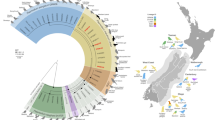Abstract
Anisakiasis is the infestation of man by the third larval stage of the Anisakidae family parasites, caused by the consumption of raw or undercooked seafood. The hosts of the third larvae parasite are marine fishes, among which Sardina pilchardus is of high commercial interest in many countries. So, the detection of anisakid larvae in fisheries products (fresh and processed) is of great interest to a rapid and feasible diagnosis of parasitism. Currently, there are different types of parasite detection methods but they are all difficult and tedious. The aim of this work was to detect, using DNA-based techniques, the presence of anisakid larvae in the entire fish host. Three pairs of primers were designed in the 18 S DNA gene taking into account the maximum matching between the anisakid species sequences and the minimum matching concerning for both the fish species and some other groups of organisms that parasitize fish (non-anisakid nematodes, trematodes, and cestodes). Experimental mixtures of parasite and fish host were made and the sensitivity of anisakid DNA detection tested by PCR. All the above primers and two others combinations of them were specific for the nematode group within the studied species, and the sensitivity of detection was on the order of 1 part of nematode to 100 000 parts of fish (anisakid weight:fish sample fresh weight = 1:≈100 000).

Similar content being viewed by others
References
Ward D, Bernard D, Collette R, Kraemer D, Hart K, Price R, Otwell S (1997) Hazards found in seafoods, Appendix III. In HACCP: Hazard analysis and critical control point training curriculum: 173–188
Ruitenberg EJ, van Knapen F, Weiss JW (1979) Vet Q 1:5–13
Myjak P, Szostakowska B, Wojciechowski J, Pietkiewicz H Rokicki J (1994) Arch Fish Mar Res 42(2):149–161
Sakanary JA, Mckerrow JH (1989) Clin Microbiol Rev 2:278–284
Ishikura H, Kikuchi K, Nagasawa K (1993) In: Sun T (ed) Progress in clinical parasitology. Springer-Verlag, New York, 3:43–101
Huss HH, Reilly A, Ben Embarek PK (2000) Food Control 11:149–156
Louredo A, Rosa F, Arribas V, Sanz E, Bernardo L, Goyanes A (1997) Rev Esp Enferm Dig 89(5):403–406
Ortega JD Martinez-Cocera C (2000) Alergol Inmunol Clin 15:267–272
Karl H, Roepstorff A, Huss HH, Bloemsa B (1995) J Food Technol 29:661–670
Baeza ML, Zubeldia JM, Rubio M (2001) ACI Int 13/6
Audicana L, Audicana M, Corres L, Kennedy M (1997) Vet Rec, March 1
Montoro A, Perteguer MJ, Chivato T, Laguna R, Cuellar C (1996) Allergy 51:27
Fernandez de Corres L, Audicana M, del Pozo M, Munoz D, Fernandez E, Navarro J, Garcia M, Diez J (1996) J Invest Allergol Clin Immunol 6:315–319
Estrada RJL, Gozalo RF (1997) Allergol Immunopathol 25:95–97
Sastre J, Lluch-Bernal M, Fernández-Caldas E, Marañón F, Quirce S, Arrieta I, Del Amo A, Lahoz C (2000) Alergol Inmunol Clin 15:225–229
Audicana M, Ansotegui I, Corres L, Kennedy M (2002) Trends in Parasitology 18(1):20–25
Lu CC, Nguyen S, Morris, Hill D, Sakanari AJ (1998) Exp. Parasitol 89:257–261
Buendia E (2000) Alergol Inmunol Clin 15:221–222
Chitwood B, Chitwood M (1974) Introduction to Nematology. University Park Press, Baltimore.
Dixon BR (1995) Isolation and identification of anisakid rounworm larvae in fish. Gouvernement du Canada, Health Protection Branch, ExFLP-1, September
del Pozo MD, Moneo I, Fernandez de Corres L, Audicana MT, Munoz D, Fernandez E, Navarro JA, Garcia M (1996) J Allergy Clin Immunol 97:977–84
Iglesias R, Leiro J, Ubeira F, Santamarina M, Navarrete I, Sanmartin M (1996) Parasitol Res 82:378–381
Mattiucci S, dAmelio S, Rokicki J (1989) Parassitologia 31:45–49
Brattey J, Davidson W (1996) Can J Fish Aquat Sci 53(2):342–349
Després L, Adamson M, McDonald T (1994) Can J Fish Aquat Sci 52(1):129–133
Renon P, Malandra R (1993) Arch Vet Ital 44(3):118-130
Sakanari JA, McKerrow JH(1989) Clin Microbiol Rev 2(3):278–284
Smith JW, Wootten R (1984) Pseudoterranova larvae (codworm) (Nematoda) in fish. Fiches didentification des maladies et parasites des poissons, crustacés et mollusques, CIEM, fiches nos 7, 8 et 9.
Berland B (1991) Hysterothylacium aduncum (Nematoda) in fish. Fiches didentification des maladies et parasites des poissons, crustacés et mollusques, CIEM, fiche no 44
Hartwich G (1974) In: Anderson RC, Chabaud AG, Willmott S (eds) CIH keys to the nematode parasites of vertebrates. Commonwealth agricultural bureau, Farnham royal,UK, pp 1–15
Blaxter ML, De Ley P, Garey JR, Liu LX, Scheldeman P, Vierstraete JR, Mackey LY, Dorris M, Frisse LF, Vida JT, Thomas WK (1998) Nature 392:71–75
Markell EK, John DT, Krotoski WA (1999) Markell and Voge's Medical Parasitology. 8th ed. WB Saunders, Philadelphia, PA, pp 269–303
Acknowledgements
We wish to thank René Galzin and Joseph Jourdane who kindly provided all the laboratory support for the work. We acknowledge the technical assistance on equipment and services managed by Jean François Allienne. We also thank Paula Ramos from IPIMAR and Stephanie Leroy, Jérome Boissier, and Andrea Simkova from the Laboratoire de Biologie Animale for gifts of nematode and trematode samples. Finally, we are grateful to Eric Taylor for his advices on the English correction of this manuscript. The work was supported by the grant SFRH/BSAB/223/2001 from POCTI (Formar e Qualificar–Medida 1.1) from FCT
Author information
Authors and Affiliations
Corresponding author
Rights and permissions
About this article
Cite this article
Santos, A.T., Sasal, P., Verneau, O. et al. A method to detect the parasitic nematodes from the family Anisakidae, in Sardina pilchardus, using specific primers of 18 S DNA gene. Eur Food Res Technol 222, 71–77 (2006). https://doi.org/10.1007/s00217-005-0052-8
Received:
Revised:
Published:
Issue Date:
DOI: https://doi.org/10.1007/s00217-005-0052-8




